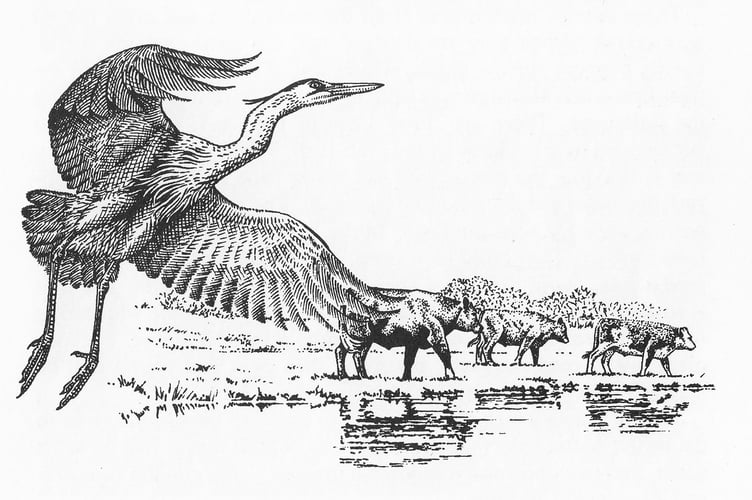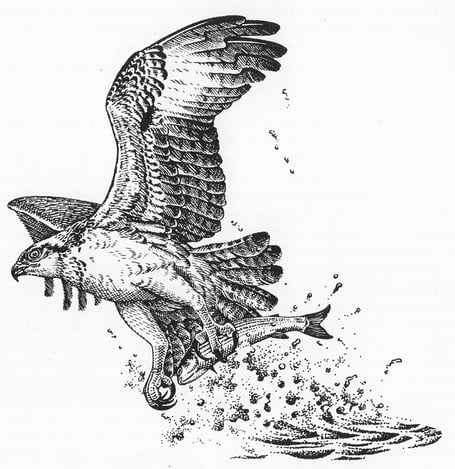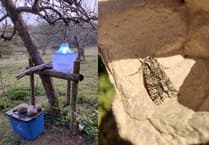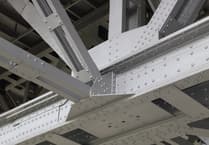It is amazing how a good artist can conjure up the character of a place or a creature, human or otherwise , in a few wiggly lines on a piece of paper. Mick Loates did just that in a series of pen and ink sketches he produced for ‘Wildlife of the Salcombe and Kingsbridge Estuary’, which we published in 1992. This picture of The Saltstone, is so simple yet so evocative of that special place. Mick’s pictures were used again for the celebration of the estuary being declared a Local Nature Reserve in the 1990s.
Now they have helped in selling ‘Birds of the Salcombe and Kingsbridge Estuary’ , raising over three thousand pounds for the upkeep of the hide. Thank you, Mick. The pictures have not aged; they look as fresh as when I first saw them. Mick is still living among us in the South Hams, enjoying looking over our estuary, walking along Slapton Line and admiring the exploits of his grandchildren.
When the tide rises, as it has in Mick’s picture of the cormorants on the Saltstone, the wading birds head for high tide roosting areas. One of these roosts is at Rowden Point, where Blanksmill and Collapit Creeks merge. Mick has arranged a group of curlews, oystercatchers and a grey plover there, creating a sense of calm, emphasised by the delicate reflections.

The next scene is set on Frogmore Creek and is far from calm. It shows the drama of an osprey catching a grey mullet. Bryan Ashby nearly captured this happening many years ago but his camera ran out of film at the critical moment! Michael Brooking and Lloyd Gray have both taken some spectacular images of ospreys but Mick’s creation takes some beating.
Mick drew another action picture on Charleton Marsh, of the cattle and a grey heron in the moment of take-off. The heron is one of the icons of all estuaries. Unlike the egrets, the heron has been part of estuary life for hundreds of years. In 1870 a Captain Gervase Matthew visited Salcombe to look for large blue butterflies. He took a horse-drawn coach from Dartmouth to Kingsbridge, then a paddle steamer down the estuary to Salcombe. He wrote, later, “On the mud-banks stately herons stood and watched us, as we steamed by, or, rising, flew in a flapping, lazy manner.” Mick has caught that ‘rising and flapping in a lazy manner’, perfectly.

For most of his life, Mick Loates has been fascinated by the books and character of Henry Williamson. He has read all his books, from ‘Tarka the Otter’ to all the novels in the semi-autobiographical ‘Chronicle of Ancient
Sunlight’, including ‘The Innocent Moon’, which is set in the South Hams. He illustrated and wrote the foreword to a special edition of Williamson’s ‘Salar the Salmon’, in 1987. He has been a key member of the Henry Williamson Society for many years, writing articles and providing countless, free illustrations. Like Williamson, Mick likes nothing better than walking along Slapton Line on a windy day.
The choice of Salar, as the Williamson book he was asked to illustrate, is appropriate, for Mick is a passionate fisherman. Much of his professional work has involved illustrations of fish for books and magazines. In the 1990s Collins, the publishers, asked him if he would illustrate their forth-coming guide to all the fish of Britain and Europe. He accepted and over several years produced more than 2,000 paintings, many of them of the fish in their natural surroundings. The result was a glorious and informative book, published in 1997.
He also illustrated Tony Soper’s ‘Oceans of Birds’, where Mick is described as, “a fully-fledged member of the world of top-flight wildlife artists.”
Finally, we return to Charleton Marsh, by the hide. In ‘Birds of the Salcombe and Kingsbridge Estuary’, I said that, for several years, shelduck had stopped breeding on the estuary. The book is out-of-date! This June, Chris Klee, looking out over the marsh from the hide, saw a pair of shelduck with about a dozen ducklings. – a wonderful sight. Mick Loates has brought the family of shelducks in this portrait to life – he’s a master.






Comments
This article has no comments yet. Be the first to leave a comment.